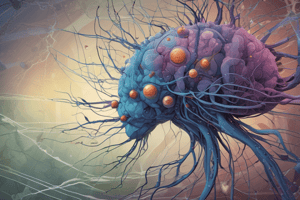Podcast
Questions and Answers
Gebelik sırasında uterusa röntgen ışıklarının uygulanması hangi konjenital anomalilere neden olabilir?
Gebelik sırasında uterusa röntgen ışıklarının uygulanması hangi konjenital anomalilere neden olabilir?
- Spontan düşük
- Konjenital mikrosefalus (correct)
- Beyincik gelişim yetersizliği
- Hemisfer gelişememe
Konjenital anomalilerin neden olduğu ölümlerin başlıca sebebi nedir?
Konjenital anomalilerin neden olduğu ölümlerin başlıca sebebi nedir?
- Konjenital mikrosefalus
- İntrauterin hayatın son 3 ayında gerçekleşen ölümler
- Spontan düşükler (correct)
- Doğum sonrası ilk 4 hafta içinde gerçekleşen ölümler
Hangi durumda beyinde gelişme yetersizliği ve mikrogri (beyin kıvrımlarının az oluşu) görülebilir?
Hangi durumda beyinde gelişme yetersizliği ve mikrogri (beyin kıvrımlarının az oluşu) görülebilir?
- Hemisfer gelişememe
- Beyincik gelişim yetersizliği
- Uterusa röntgen ışıklarının uygulanması (correct)
- Spontan düşük
Konjenital anomalilerin meydana geldiği dönemde gerçekleşen ölümlerin çoğu hangi süreçte gerçekleşir?
Konjenital anomalilerin meydana geldiği dönemde gerçekleşen ölümlerin çoğu hangi süreçte gerçekleşir?
Konjenital bozukluk gösteren hastaların bir kısmı hangi durumla karşılaşabilir?
Konjenital bozukluk gösteren hastaların bir kısmı hangi durumla karşılaşabilir?
Flashcards are hidden until you start studying
Study Notes
-
In an organism, the following functions typically occur in cells: growth and development (including mitosis, meiosis, differentiation), regeneration, protection, metabolism, excretion, nerve and impulse transmission, and psychological life.
-
In growth and development anomalies, two main categories can be identified: intrauterine development and postnatal life.
-
Intrauterine development anomalies include: hyperfunction, general local hypofunction, specific primordial tissue defects, such as skeletal dysplasia, local aneplasia, hipoplasia, developmental errors-anomalies, congenital anomalies' causes, facilitating factors, and teratogenic influences.
-
Hipoplasia refers to an organ's growth that falls below normal size. The organ's appearance may be normal, but its volume is smaller. In organs affected by hypoplasia, cell numbers and sizes are below normal ranges.
-
Microcephaly: when the brain fails to develop fully, it is called microcephaly. This condition can be detected during pregnancy by the absence of fetal X-ray signals and calcifications, and during birth by the brain's small size and underdevelopment in certain brain regions, such as the cerebellum or hemisphere. In some cases, only certain brain regions may show developmental insufficiency, resulting in microgyria (reduced brain folds).
-
Congenital anomalies (birth defects): most infant deaths in the first year occur within the first month after birth, with congenital anomalies being the leading cause. Embryonic anomalies can cause spontaneous abortions within the first three months of pregnancy. In the final three months of pregnancy, congenital anomalies are also significant contributors to infant mortality.
-
Among those with congenital anomalies, a significant portion have dysfunction.
-
In the intrauterine development anomalies, hyperfunction can lead to general or local hypofunction. Genetic, local, and primordial tissue defects can result in skeletal dysplasia, aneplasia, hipoplasia, developmental errors-anomalies, and congenital anomalies' causes. Facilitating factors and teratogenic influences can contribute to these defects.
-
Hipoplasia occurs when an organ's growth falls below normal limits. In organs affected by hypoplasia, the number of cells and their size are below normal ranges.
-
Microcephaly is a condition where the brain fails to develop fully, resulting in a smaller brain size and underdevelopment of certain brain regions, such as the cerebellum or hemisphere. In some cases, only certain brain regions may show developmental insufficiency, leading to microgyria (reduced brain folds).
-
Among those with congenital anomalies, a significant portion displays dysfunction.
-
Intrauterine development anomalies can be classified as hyperfunction, general local hypofunction, and specific primordial tissue defects. Hyperfunction can lead to general or local hypofunction. Genetic, local, and primordial tissue defects can result in skeletal dysplasia, aneplasia, hipoplasia, developmental errors-anomalies, and congenital anomalies' causes. Facilitating factors and teratogenic influences can contribute to these defects.
-
Hipoplasia is a condition characterized by an organ's growth that falls below normal limits. In organs affected by hypoplasia, the number of cells and their size are below normal ranges.
-
Microcephaly is a condition where the brain fails to develop fully, resulting in a smaller brain size and underdevelopment of certain brain regions, such as the cerebellum or hemisphere. In some cases, only certain brain regions may show developmental insufficiency, leading to microgyria (reduced brain folds).
-
Among those with congenital anomalies, a significant portion displays dysfunction.
-
Intrauterine development anomalies include hyperfunction, general local hypofunction, and specific primordial tissue defects. Hyperfunction can lead to general or local hypofunction. Genetic, local, and primordial tissue defects can result in skeletal dysplasia, aneplasia, hipoplasia, developmental errors-anomalies, and congenital anomalies' causes. Facilitating factors and teratogenic influences can contribute to these defects.
-
Hipoplasia is a condition characterized by an organ's growth that falls below normal limits. In organs affected by hypoplasia, the number of cells and their size are below normal ranges.
-
Microcephaly is a condition where the brain fails to develop fully, resulting in a smaller brain size and underdevelopment of certain brain regions, such as the cerebellum or hemisphere. In some cases, only certain brain regions may show developmental insufficiency, leading to microgyria (reduced brain folds).
-
Among those with congenital anomalies, a significant portion displays dysfunction.
-
Intrauterine development anomalies include hyperfunction, general local hypofunction, and specific primordial tissue defects. Hyperfunction can lead to general or local hypofunction. Genetic, local, and primordial tissue defects can result in skeletal dysplasia, aneplasia, hipoplasia, developmental errors-anomalies, and congenital anomalies' causes. Facilitating factors and teratogenic influences can contribute to these defects.
-
Hipoplasia is a condition characterized by an organ's growth that falls below normal limits. In organs affected by hypoplasia, the number of cells and their size are below normal ranges.
-
Microcephaly is a condition where the brain fails to develop fully, resulting in a smaller brain size and underdevelopment of certain brain regions, such as the cerebellum or hemisphere. In some cases, only certain brain regions may show developmental insufficiency, leading to microgyria (reduced brain folds).
-
Among those with congenital anomalies, a significant portion displays dysfunction.
-
Congenital anomalies (birth defects) make up a significant portion of deaths in the first year of life, with most occurring within the first month. Embryonic anomalies can cause spontaneous abortions in the first three months of pregnancy. In the final three months of pregnancy, congenital anomalies are also a leading cause of infant mortality.
-
Among those with congenital anomalies, a significant proportion displays dysfunction.
-
Microcephaly is a condition characterized by a smaller brain size and underdevelopment of certain brain regions, such as the cerebellum or hemisphere. In some cases, only certain brain regions may show developmental insufficiency, leading to microgyria (reduced brain folds).
-
Hipoplasia is a condition where an organ's growth falls below normal limits, resulting in a smaller number of cells and smaller cell size.
-
Intrauterine development anomalies include hyperfunction, general local hypofunction, and specific primordial tissue defects. Hyperfunction can lead to general or local hypofunction. Genetic, local, and primordial tissue defects can result in skeletal dysplasia, aneplasia, hipoplasia, developmental errors-anomalies, and congenital anomalies' causes. Facilitating factors and teratogenic influences can contribute to these defects.
-
Among those with congenital anomalies, a significant proportion displays dysfunction.
-
Microcephaly is a condition where the brain fails to develop fully, resulting in a smaller brain size and underdevelopment of certain brain regions. In some cases, only certain brain regions may show developmental insufficiency, leading to microgyria (reduced brain folds).
-
Hipoplasia is a condition where an organ's growth falls below normal limits, resulting in a smaller number of cells and smaller cell size.
-
Intrauterine development anomalies include hyperfunction, general local hypofunction, and specific primordial tissue defects. Hyperfunction can lead to general or local hypofunction. Genetic, local, and primordial tissue defects can result in skeletal dysplasia, aneplasia, hipoplasia, developmental errors-anomalies, and congenital anomalies' causes. Facilitating factors and teratogenic influences can contribute to these defects.
-
Microcephaly is a condition where the brain fails to develop fully, resulting in a smaller brain size and underdevelopment of certain brain regions. In some cases, only certain brain regions may show developmental insufficiency, leading to microgyria (reduced brain folds).
-
Hipoplasia is a condition where an organ's growth falls below normal limits, resulting in a smaller number of cells and smaller cell size.
-
Among those with congenital anomalies, a
Studying That Suits You
Use AI to generate personalized quizzes and flashcards to suit your learning preferences.




